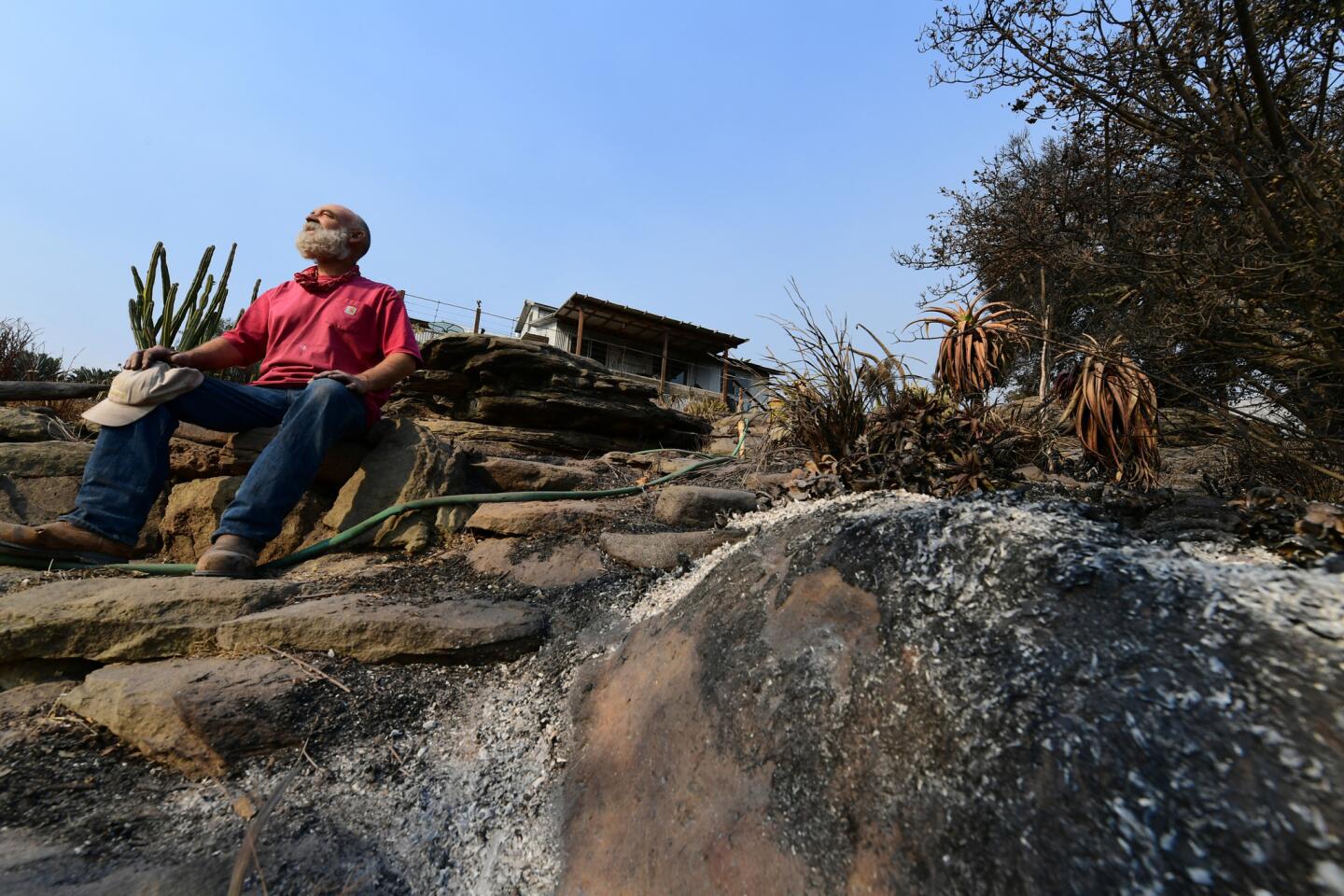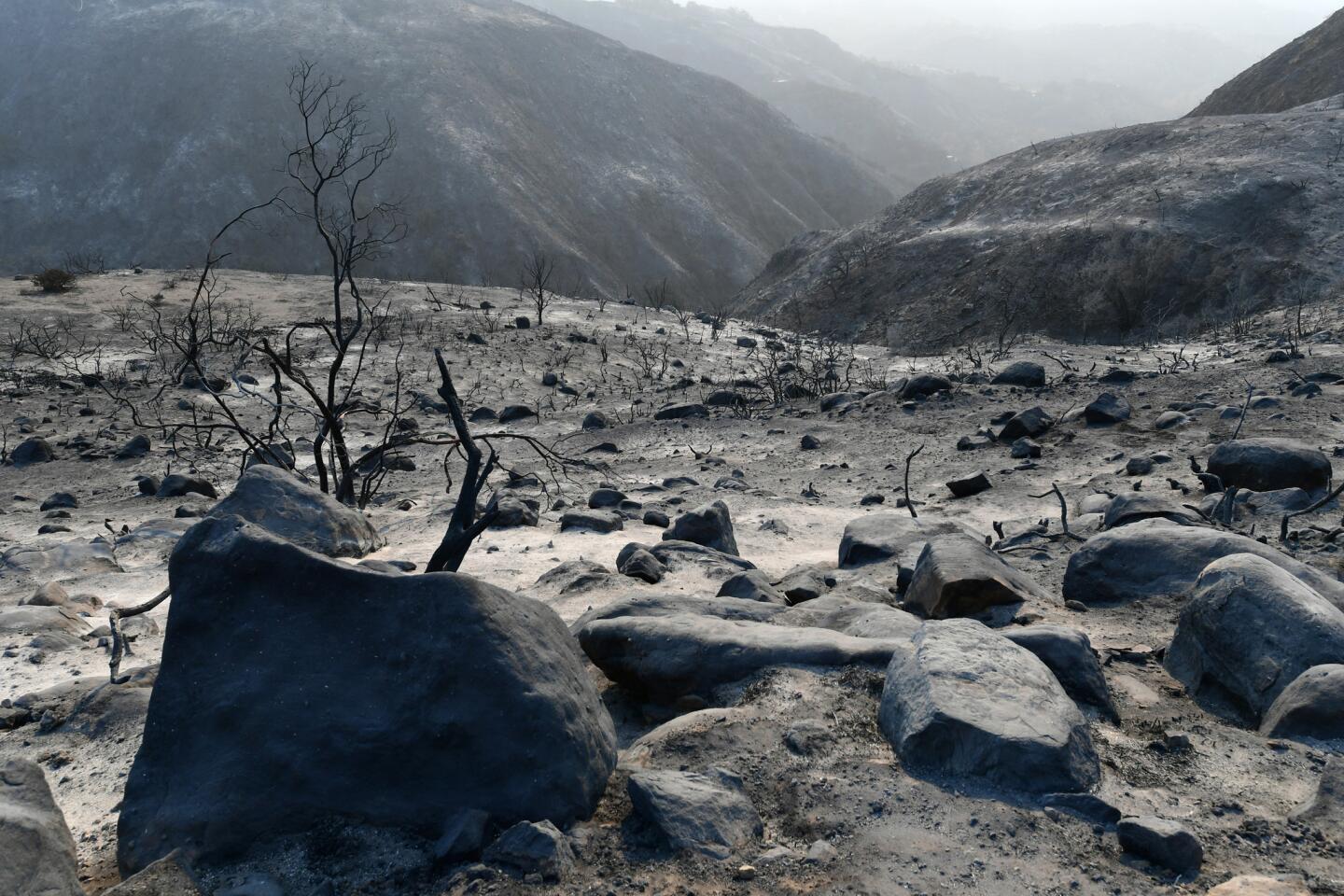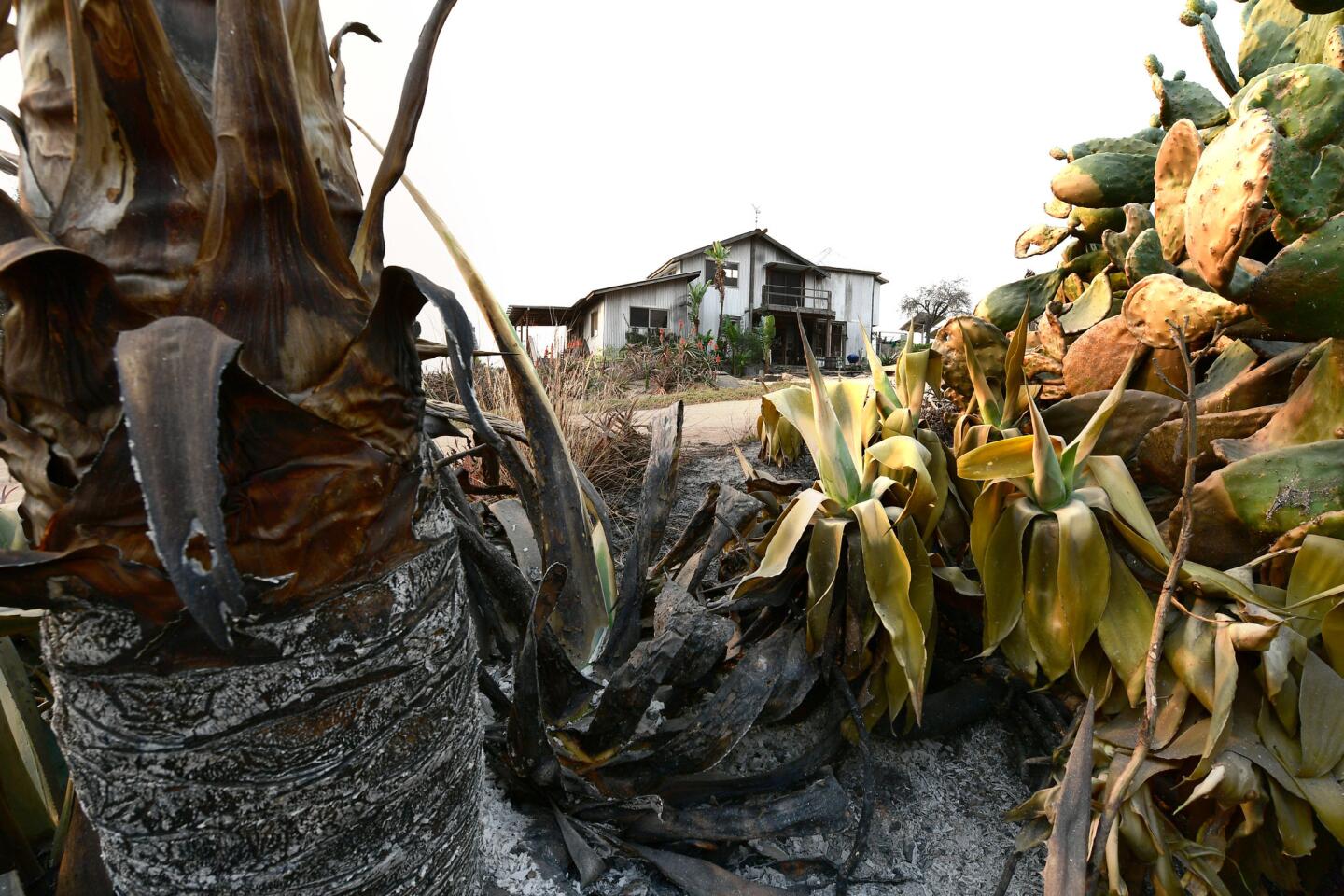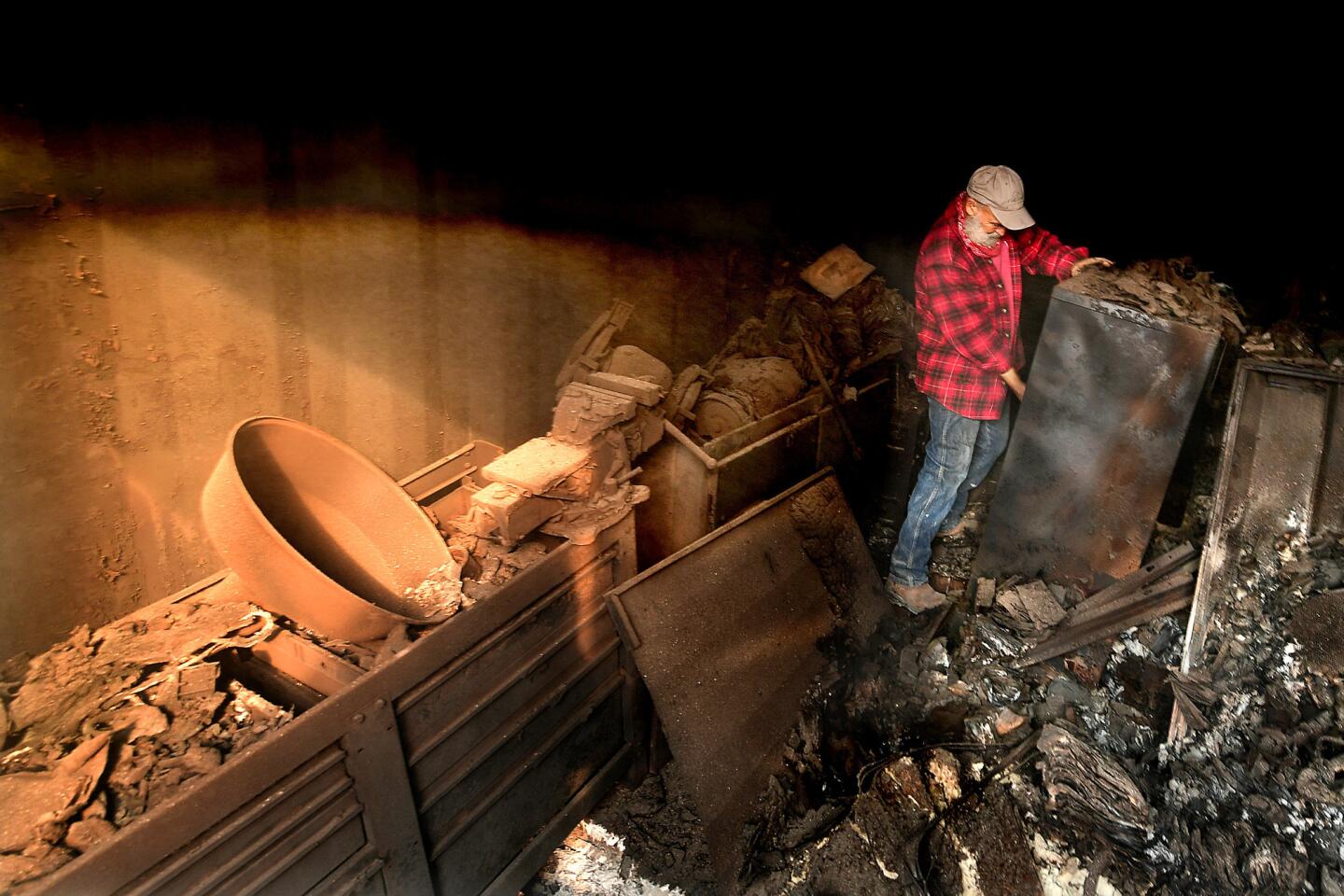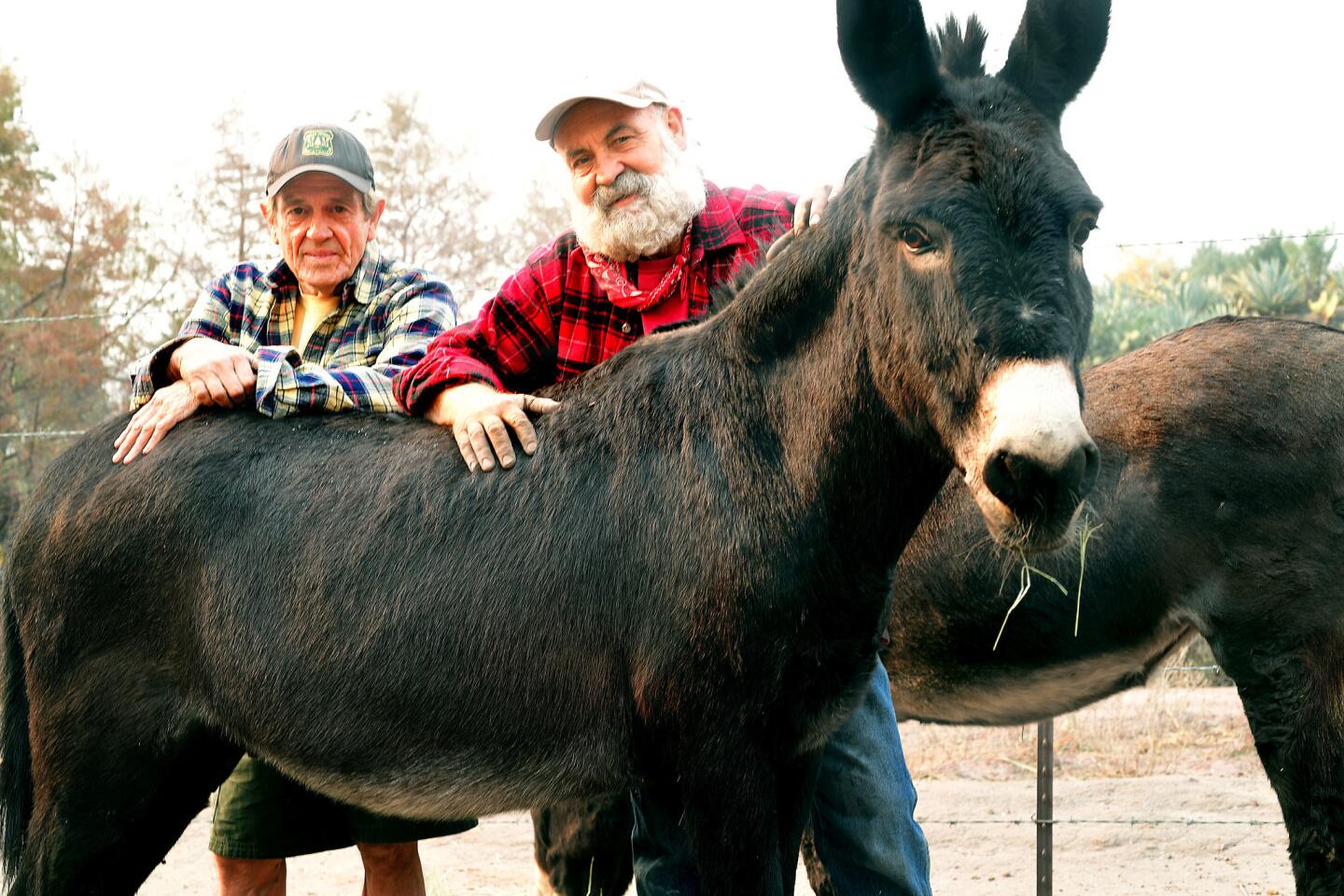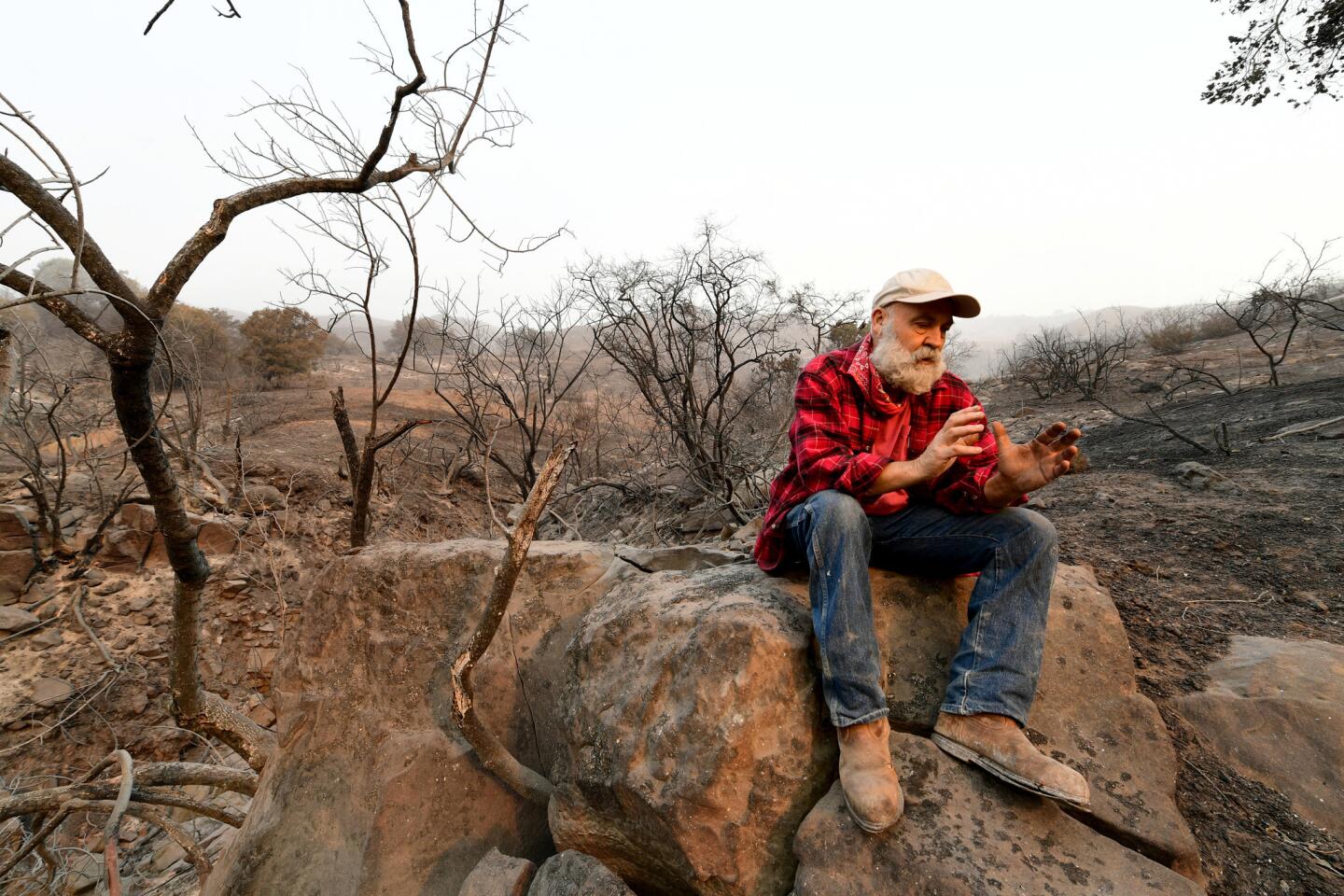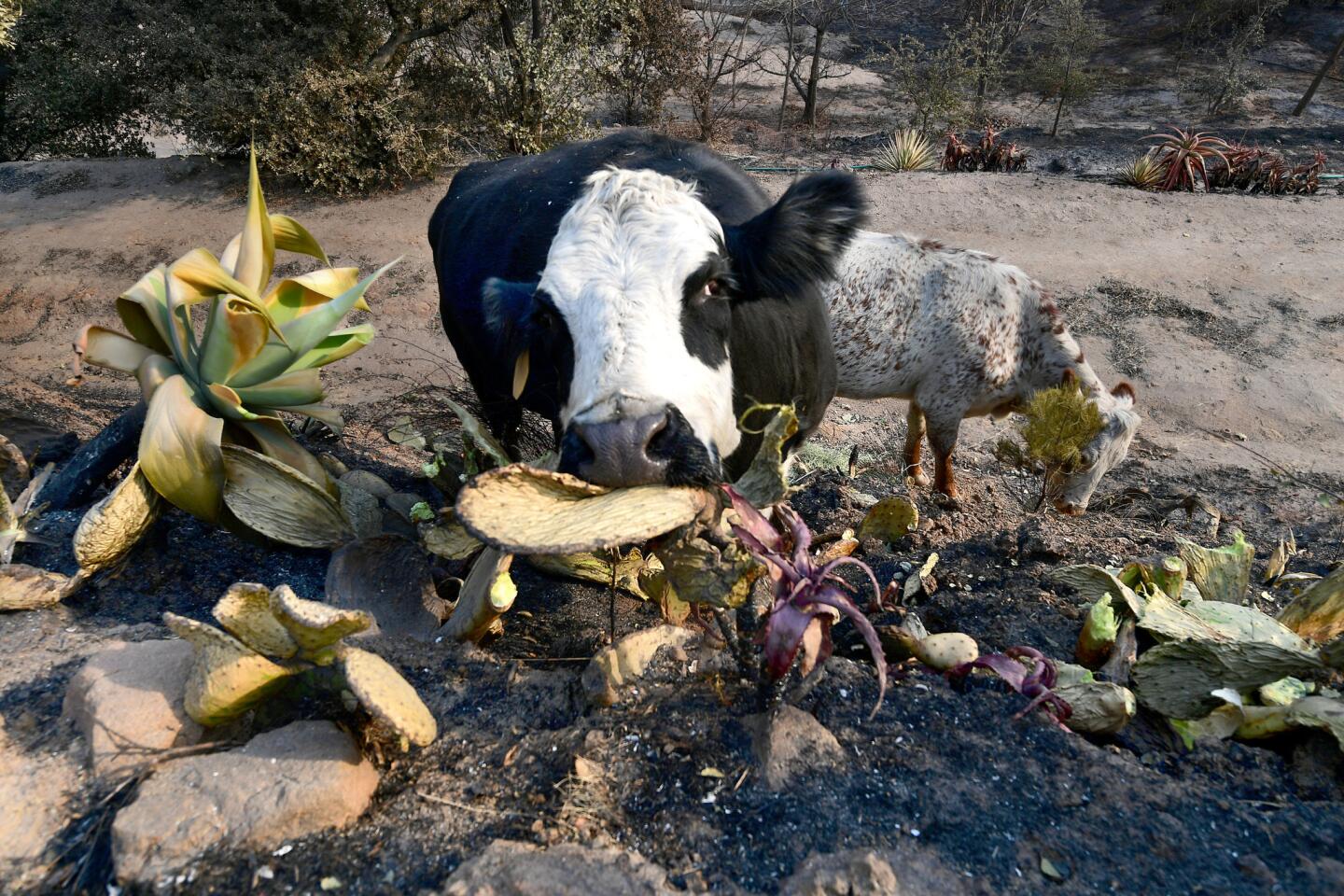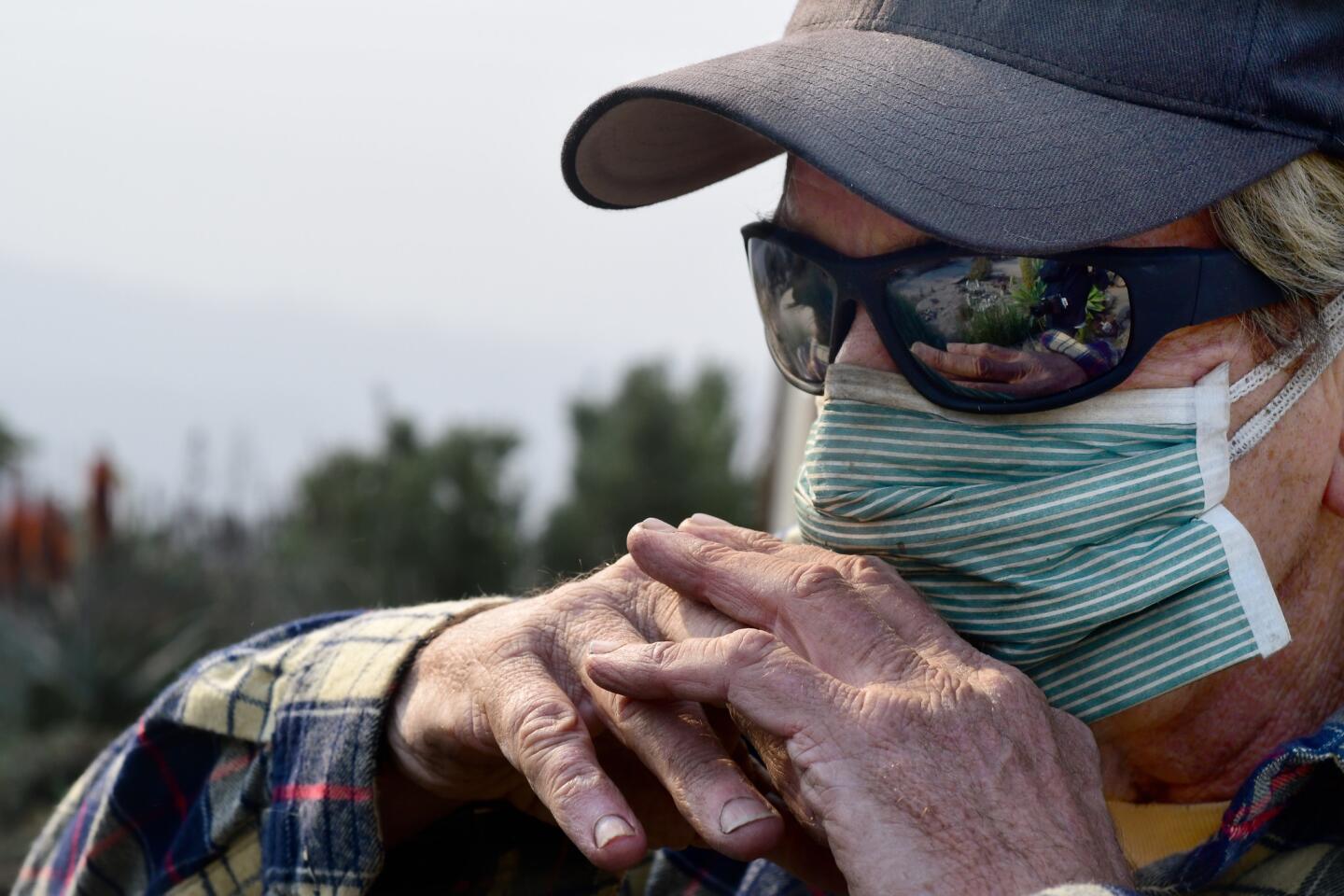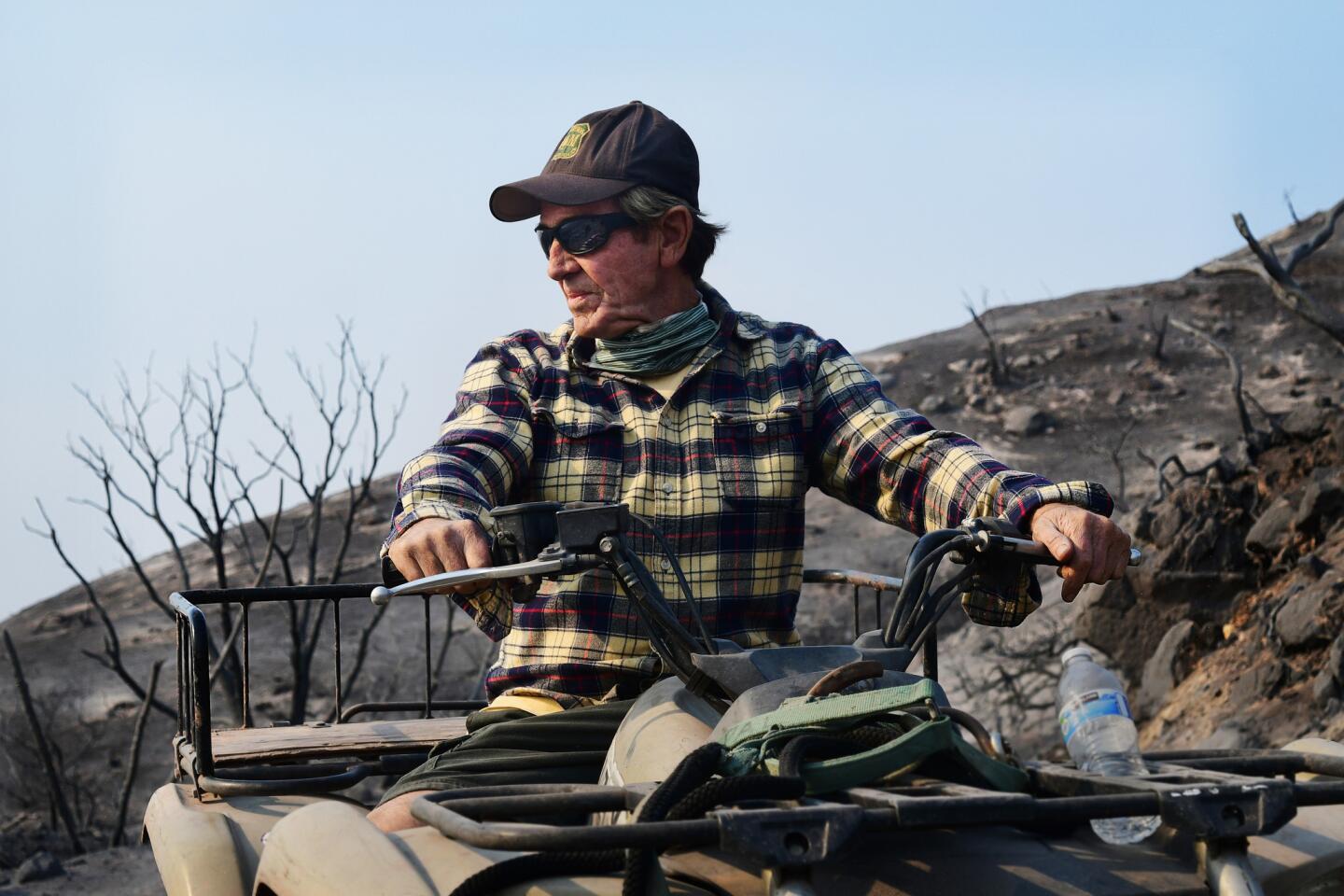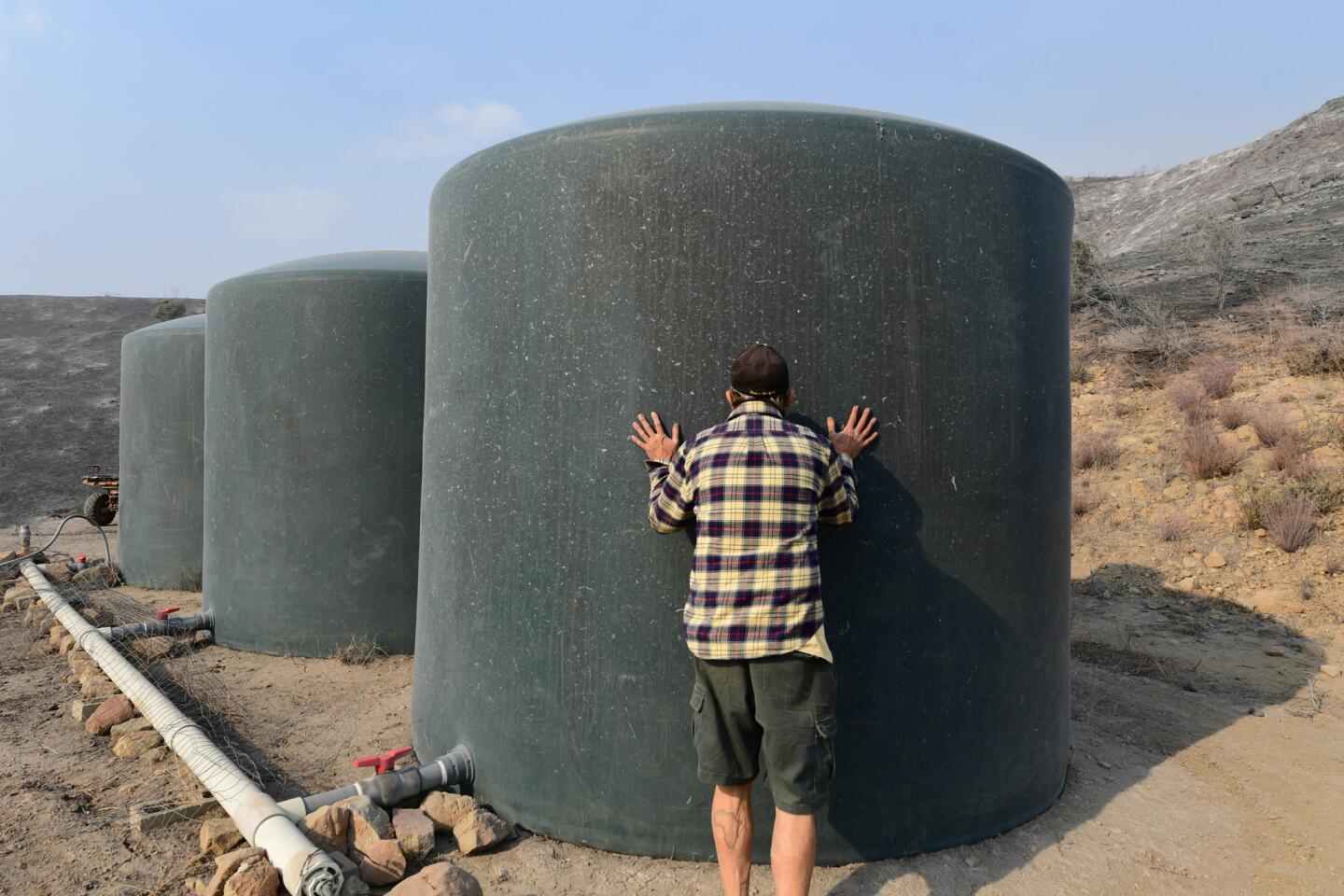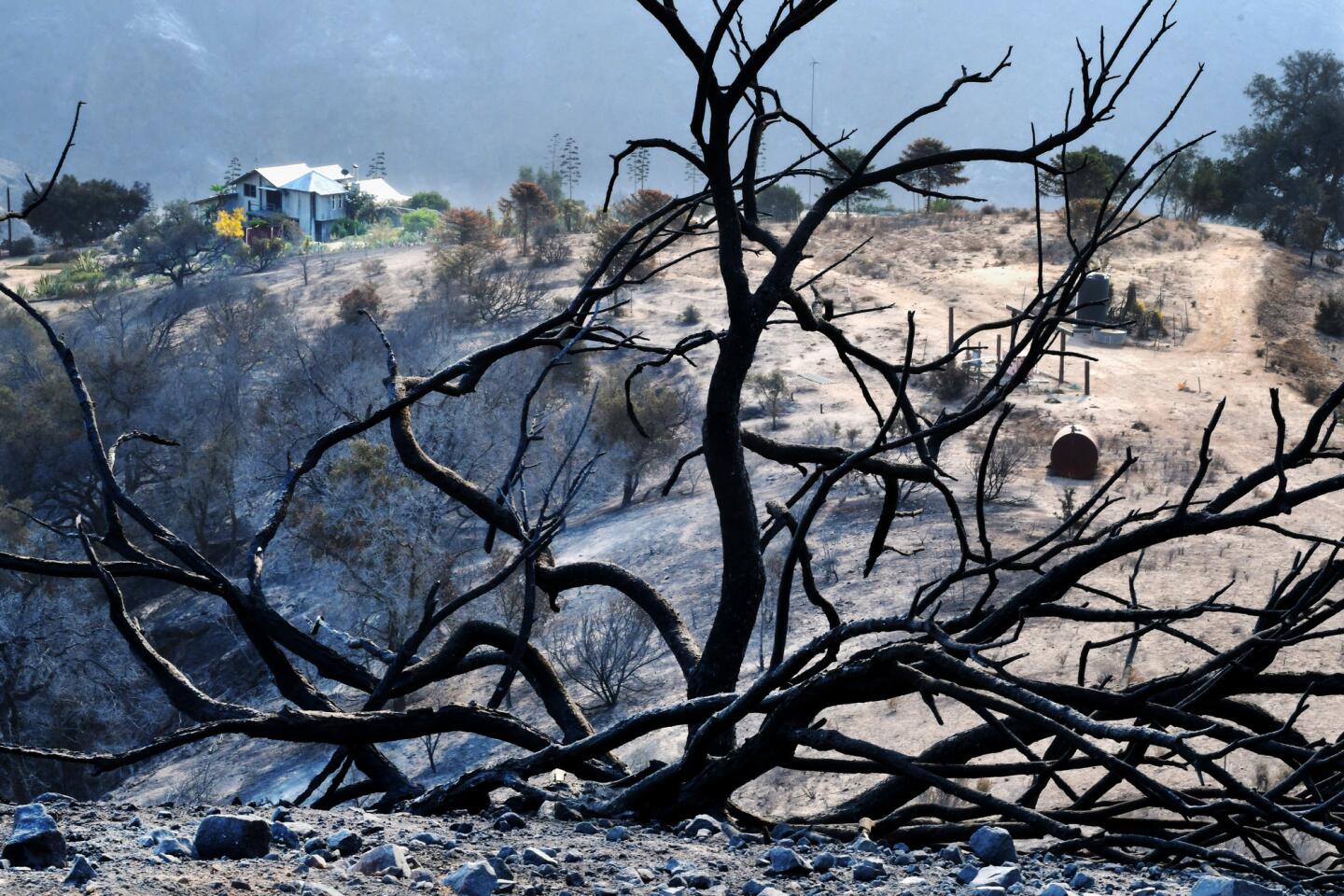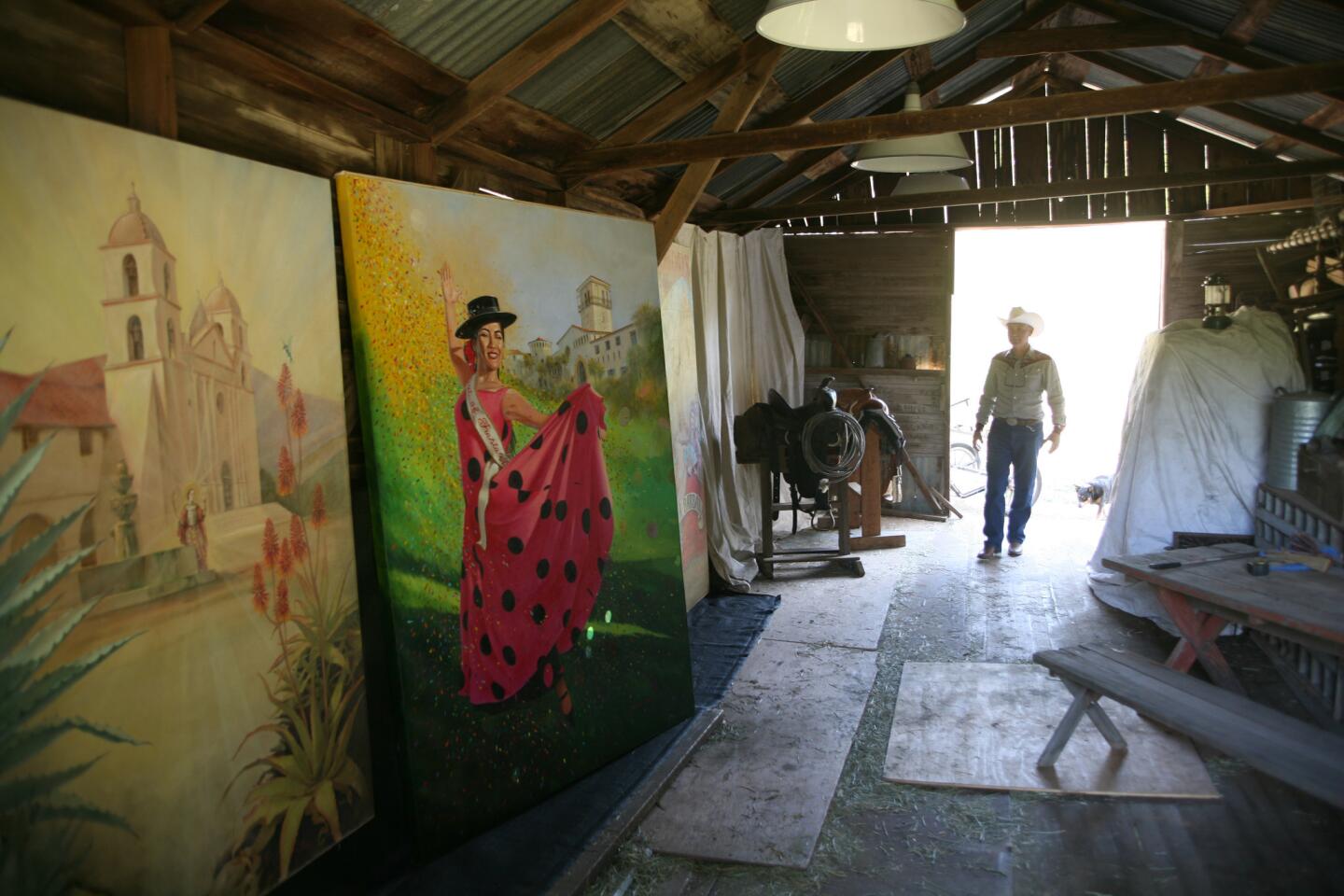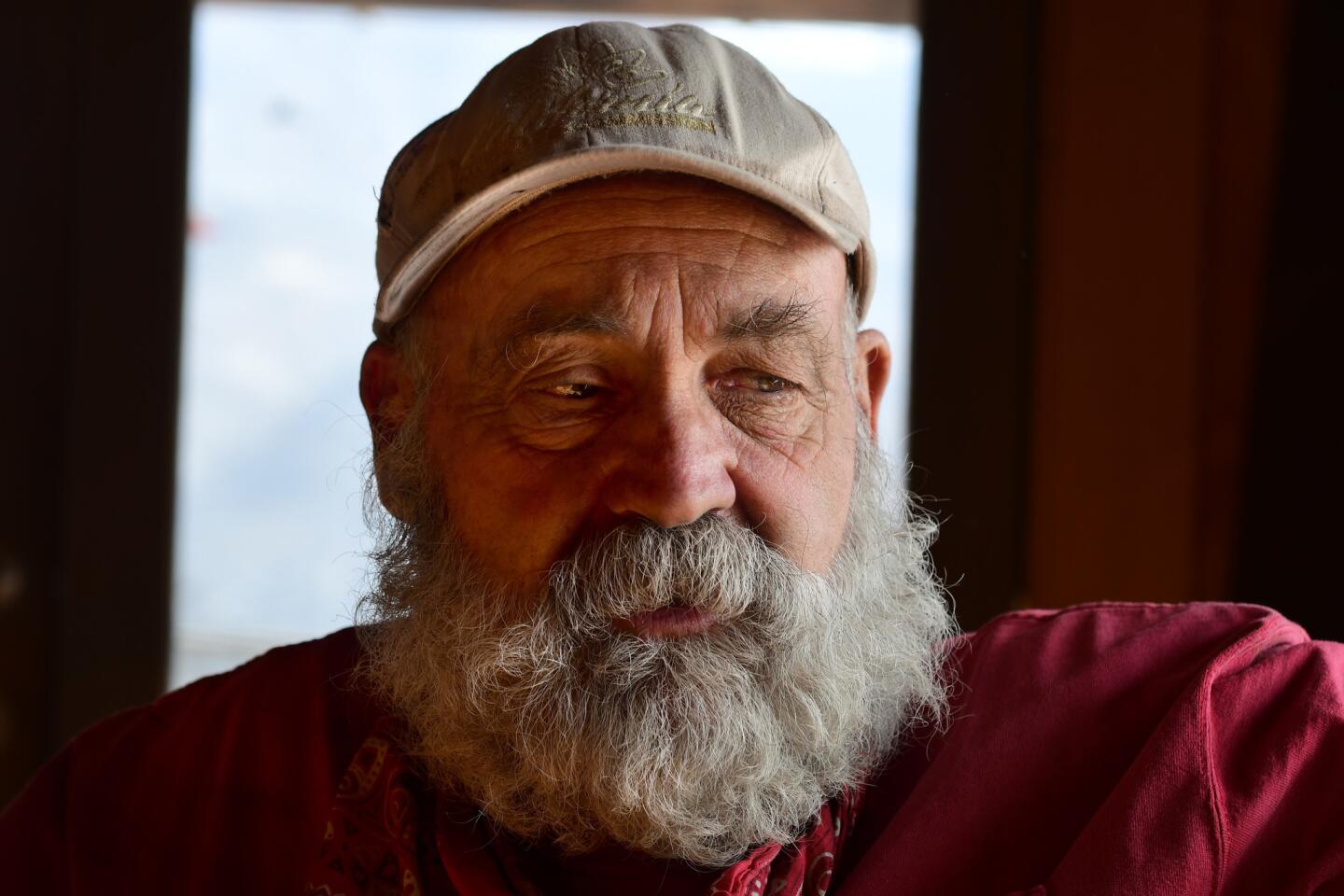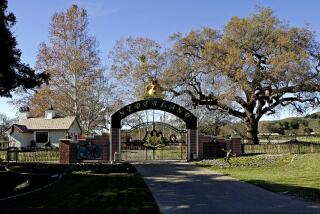Artist John Wullbrandt lost vital paintings in the Thomas fire, but found renewal in fighting the flames
It was close to midnight when the call came from a panicked neighbor. A roaring wildfire was racing down the mountain and the flames would be there soon. It was time to get out.
But John Wullbrandt, a prolific artist who’d been painting the landscape around La Granada Mountain since he was a teenager, refused to leave. He’d been preparing for this moment for the last 15 years.
The 100-acre former cattle ranch just above Carpinteria in Santa Barbara County has been in Wullbrandt’s family for four generations. Fire was always a threat.
He and his partner, Jean-Claude Rivalland, had encased the house in corrugated steel, installed three 5,000-gallon water tanks and laid 300 feet of fire hose. Each year, they cleared vegetation around the house and had circled the structure with fire-resistant succulents. Decades of his paintings, including the works he cherished most, were tucked away in two steel shipping containers he believed could withstand a wildfire. They were going to stay, and fight.

Facing firefighter recommendations to evacuate, painter John Wullbrandt and his partner Jean-Claude Rivalland decided to try and save their animals, art and property from the approaching Thomas Fire. (Video by Claire Hannah Collins / L.A. Times) Rea
Shortly after midnight on Dec. 10, as the Thomas fire raced toward them, Wullbrandt took the northeast corner of the house, Rivalland the southwest. They tied their animals — two donkeys, two cows, a mule and a horse — to the side of the house and hosed them down with water. They figured their four dogs and two cats would be safe inside the house, and the tortoise could ride out the fire in the bathtub.
Finally, the towering wall of flames reached them. They affixed their mask respirators and battled the onslaught with fire hoses, buckets of water and the animals’ drinking troughs. The fire’s deafening moan was so loud it sounded like a freight train, and the smoke so thick, they couldn’t communicate or see one another. So they fought solo, each feeling he was the last man on Earth, ensconced in scalding heat, flying embers and whirling ash.
When it was over, Wullbrandt had learned what near-death looks like: it is crimson and deep orange, as if rendered in the “Naphthol Red” and “Cadmium Orange” tubes of paint that he often works with. It is brilliant and murky at once, with flickers of gold, deep-green and blue, like the rolling hills, ripe fruit and sun-dappled beach in Wullbrandt’s downtown Carpinteria murals. In the eye of the fire, not unlike when he’s painting sometimes, Wullbrandt says he felt an otherworldly calm.
“It was like being in the epicenter of a blowtorch,” Wullbrandt says. “It took all of our might. But we were well prepared, we were confident, like when I paint — I had peace of mind. It was actually quite beautiful, haunting.”
An artist comes home
With his tanned face, bushy, Santa Claus-like beard and soft, hazel eyes, 66-year-old Wullbrandt looks like a modern-day cowboy, rugged and sensitive. He grew up in Carpinteria, where his late father, Ernest C. Wullbrandt, served multiple terms as mayor. The sleepy beach town was spared from the fire, the largest in California history, but is still dangerously smoky more than a week after the first flames. As Wullbrandt strolls down the ash-speckled sidewalks of Wullbrandt Way — named after his father — he stirs a “big man on campus” reaction. Neighbors, friends, local business owners — some wearing dust masks as they run errands — nod as they pass by, often slapping him on the shoulder or stopping for hugs.
Driving up the mountain to Wullbrandt’s ranch in his old Mitsubishi SUV, the scene along the rocky, dirt road looks like a steam punk moonscape of blackened tree skeletons coated in gray ash. Crisped shipping containers and lone propane tanks litter empty lots where houses once stood, their barbed wire fences now bent and charred. Spindly curls of smoke swirl up from the canyon below, where tree trunk stumps still smolder, their roots still sparking with fire. The air is so thick with smoke, it leaves a bitter, burnt taste with every breath. When the wind picks up, it sends enormous, billowy clouds of gray ash into the car’s path, obscuring the bumpy road ahead.
Wullbrandt left the area in 1978 for San Francisco, he explains in the car, to forge a career as an artist. He was rejected by the commercial gallery establishment there — “devastating” at the time, he says — but he made a living over more than three decades through private commissions and selling artwork to luxury hotels and resorts around the U.S. mainland and Hawaii. His pastoral scenes of local flora and fauna and illustrated cultural histories have adorned hotel suites, lobbies and golf clubhouses.
With San Francisco as his home base, Wullbrandt traveled the world for weeks at a time looking for inspiration — India, Nepal, Japan, South Africa — and making paintings. He spent time in 1994 as artist-in-residence for King George of Tonga, he says, creating interior murals for a new villa.
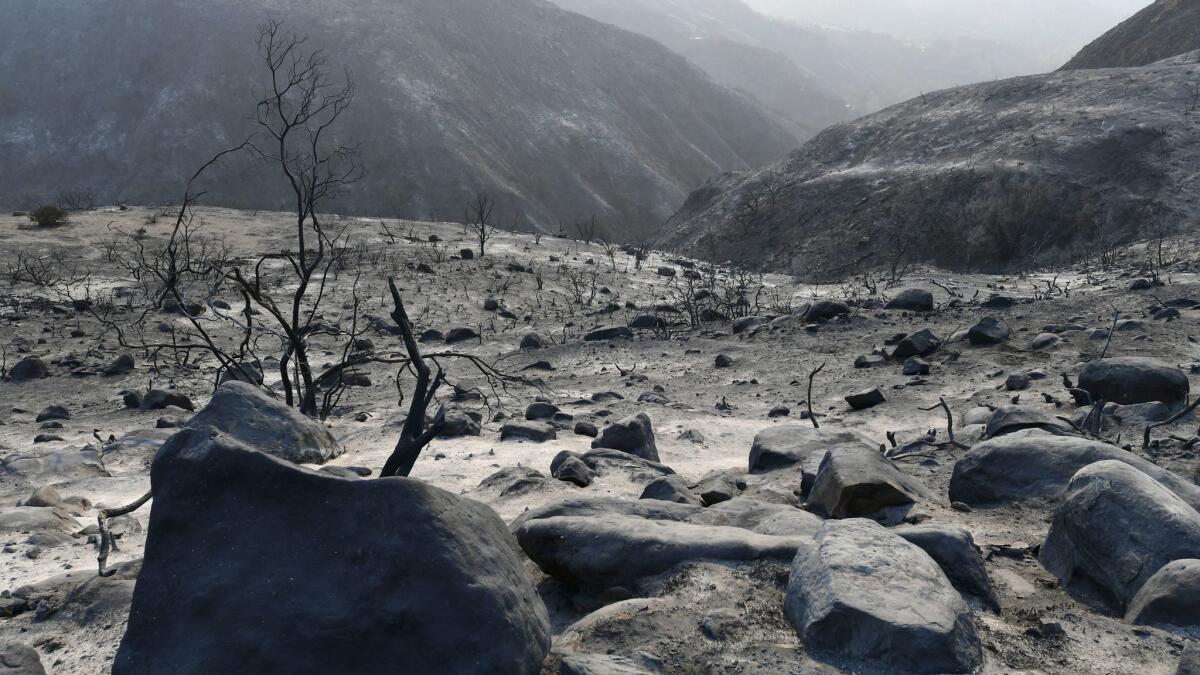
His many public artworks have included a site-specific mural about the history of the Van Nuys Airport, a city-commissioned architectural trompe l’oeil on a building in San Francisco’s Tenderloin district and multiple murals inside the Dole Food Co.’s corporate headquarters in Westlake Village.
When San Francisco became too expensive for the artist and his longtime partner, they returned to Carpinteria and in 2002 bought “El Rancho Botello,” which his great-great uncle homesteaded in 1913. It was a working cattle ranch until last year. Wullbrandt, a longtime vegetarian, suddenly had to learn how to brand and castrate cows, buck hay and herd cattle.
All the while, Wullbrandt painted, working intensely for weeks at a time in his studio formed from a stand-alone cabin encased in meta and two adjacent shipping containers situated about 600 feet from the house. Capturing the local landscape and its history is his passion. Nearly all of his neighbors own pieces of his art, he says. In 2013, the late “Fast & Furious” actor Paul Walker commissioned two pieces.
One of his works is in the collection of the Carpinteria Valley Museum of History; others are on loan to local businesses. His most recent mural, chronicling agricultural development in Carpinteria, was unveiled in the town’s center earlier this year.
Knowing that his personal collection of paintings was safe in his studio — decades of carefully rendered observations — brought him a deep sense of purpose and accomplishment.
“So many of my murals have been destroyed over the years,” he says, “I felt it was responsible to hold onto some [art] — that I was in charge of holding onto my own history.”
A flaw in the plan
The inferno, which cut through Wullbrandt’s property like “fast-flowing lava,” torched 100-year-old oaks, ceanothus trees and swaths of coyote bush. It left the outer regions of the ranch burned to a crisp, the now-ashy landscape dotted with sizzled trees, charred antique farm equipment, shattered glass and fried rat and rabbit carcasses.
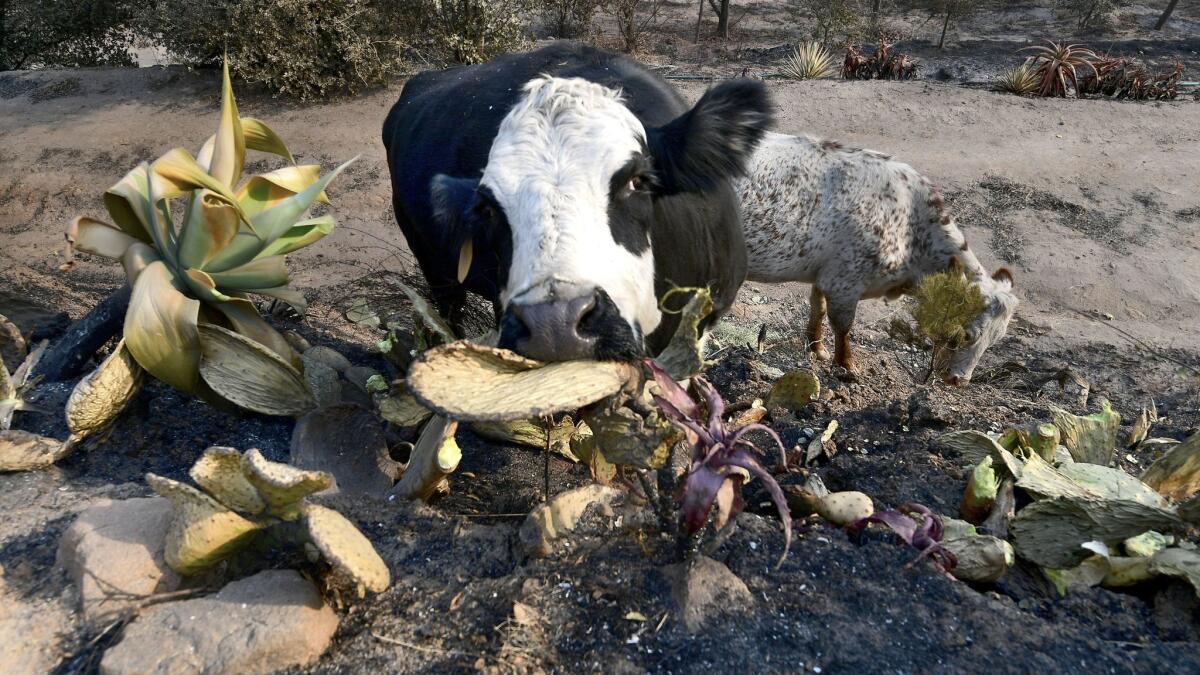
Wullbrandt admits that some might consider it irresponsible to stay at the ranch and fight the fire, especially considering the sheriff’s call, two days earlier, urging them to evacuate.
“But I’m passionate about where I live and I have the freedom to make that choice,” he says. “The ranch hadn’t burned in over 100 years, so we knew it was coming, it was inevitable. We prepared. We spent 15 years being responsible.”
And the plan worked, at least in part. The house and its immediate surroundings were untouched, save for a 1-inch burn spot on the front porch step and tiny fire lashings on the porch posts. The animals were also spared.
But all his preparations for protecting the art studio were for naught. It was burned into oblivion.
Wullbrandt knew the studio and shipping containers had wood floors, but he was certain there was metal beneath them. That was not the case. The fire blew underneath and ignited everything inside, turning decades worth of paintings into ash. The oldest work that Wullbrandt lost was a series of charcoal figurative drawings from when he was in junior high school; his most treasured work lost was a still life painting of an Art Deco vase in which he felt he’d successfully experimented with the rules of composition.
Most devastating, Wullbrandt says, is his ravaged archives: 50 years worth of letters, personal photographs and slides, portfolios of drawings and sketches, treasured books, maquettes for murals, pre-internet newspaper and magazine articles about him, along with TV and radio interviews on VHS and cassette tapes and documentation from early public art projects — all turned to dust.
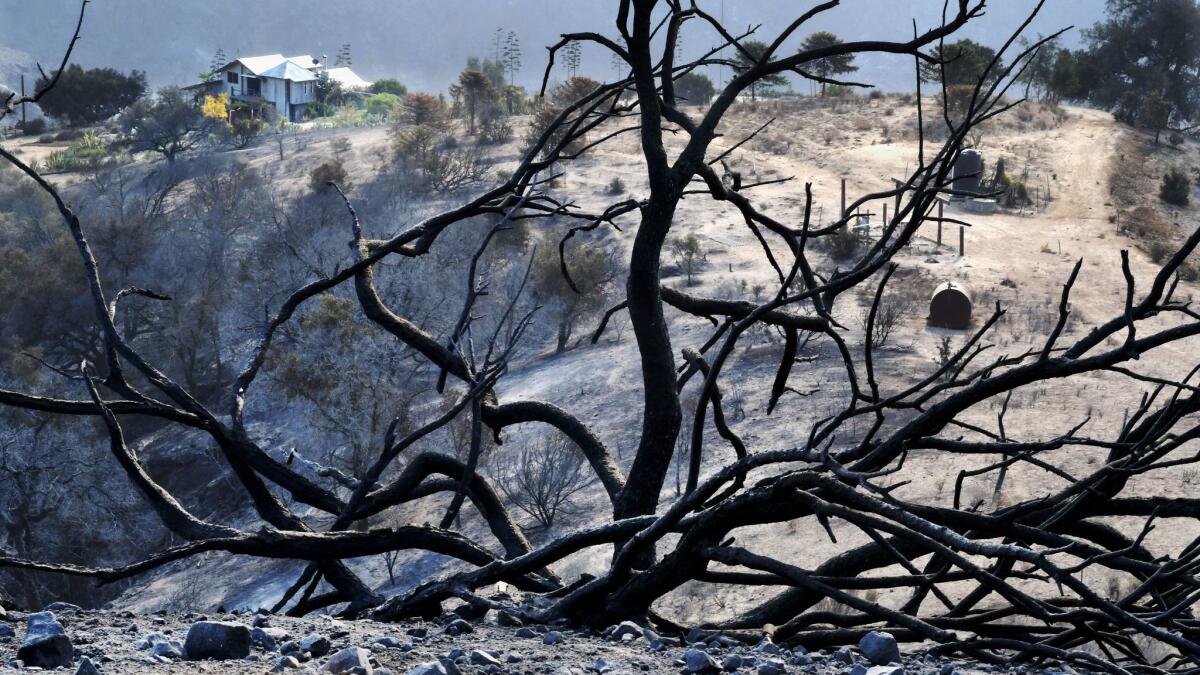
The corrugated steel barn, too, was destroyed; it also didn’t have a metal floor, as Wullbrandt had thought. He lost three significant large-scale paintings that were housed there, along with family heirloom furniture, century-old tools his family used to build the ranch and his sister’s collection of antique saddles.
“It was terrible,” he says of watching his art studio burn during the fire. “But I thought: ‘We’re alive.’”
Sorrow and liberation
This is what rejuvenation looks like: It is “Chromium Oxide Green” and “Light Blue Violet,” like the tubes of paint Wullbrandt will use in the landscape paintings he’s planning for an upcoming show. Just a week before the fire, he was voted into the Oak Group, an artists organization that raises money for environmental preservation causes. They’ll exhibit his work at the Santa Barbara Public Library’s Faulkner Gallery, as part of a group show, in the fall. He’ll also have a solo show in 2018 at Carpinteria’s Palm Loft Gallery, he says.
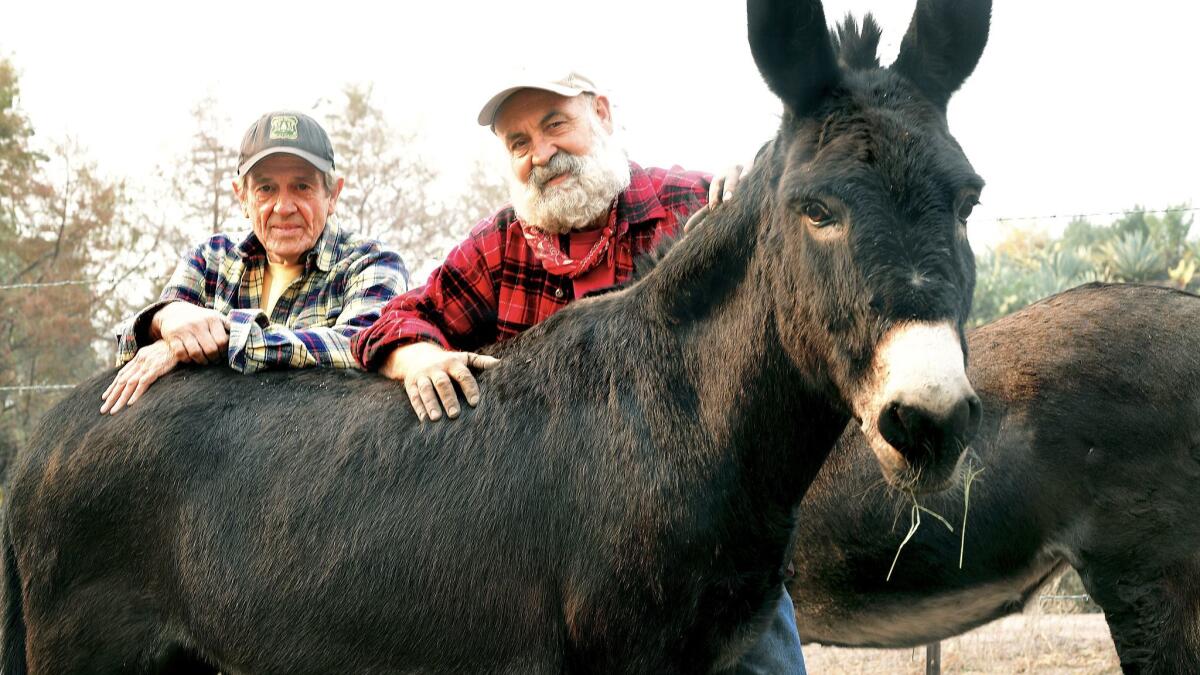
“The fire has given me an opportunity to show my work, it’s given me something to head towards,” Wullbrandt says.
Losing so much in the fire, he says, has been oddly liberating. For years, Wullbrandt meant to organize his archives. But that would have required classifying his history, and he isn’t one who likes to be pigeonholed, he says. He never clung to an artistic identity as a “muralist” or “landscape painter,” for example; instead, he’s toggled between genres, experimenting with figure drawing, magical realism, abstraction, landscapes and set design, among other styles. Losing everything frees him from the daunting task of sorting his sprawling life’s work and, for better or worse, from his personal narrative. It presented an opportunity to start anew.
“There’s not being burdened with all the trappings of my life,” he says. “I thought that one day I would take all of this archival stuff and turn it over to someone; and somehow that would validate my career. But I don’t have to do that now. I’m free to paint.”
Wullbrandt may be eerily at peace about the Thomas fire, but standing by the remains of his destroyed barn — now just layers of charred steel — he chokes up thinking about his ancestors.
“The fact that my family’s ranch burned on my watch,” he says, tears pooling in his now bloodshot eyes. “It’s been tough. But I know I did everything I could. My ancestors would be darn proud.”
The sorrow is compounded at the mention of his neighbors. “My heart goes out to those who have lost far more than I have,” he says.
Still, Wullbrandt remains optimistic. In town, Wullbrandt stops at a small garage that was once his grandfather’s plumbing shop and which he now uses for storage. He lifts the metal grate and there, piled up with the cardboard boxes, bikes and old furniture, was a glossy, 10-foot-wide painting of his ranch in better times, vibrant and alive. It depicts cowboys roping and herding cattle across dark green hills, the Carpinteria Valley and city of Santa Barbara stretching out to the sea in the background.
“Gone, all of this gone,” he says, sweeping his hand across the landscape depicted in the painting.
But with loss comes new life.
“It really will be like the Phoenix rising out of the ashes, the rebirth,” he says. “It will be so much more beautiful once it starts to rejuvenate. We’re gonna see wildflowers we haven’t seen in 100 years.”
Then Wullbrandt gazes up at a mountain ridge in the distance, now a thin, ash-gray paint stroke on the horizon.
“The spring — just wait. As an artist, I can’t wait to paint it.”
Follow me on Twitter: @debvankin
ALSO
The Cold War as a museum: At the Wende, one man’s 100,000-piece collection finds a new home
‘Unsettled’ explores the terrain — physical and political — of the West
Shepard Fairey: Have we lost the ‘street’ in street art?
More to Read
The biggest entertainment stories
Get our big stories about Hollywood, film, television, music, arts, culture and more right in your inbox as soon as they publish.
You may occasionally receive promotional content from the Los Angeles Times.
